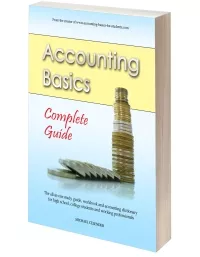Basic Journal Entries Question
by SURINDER
(Jammu)
Before you begin: It's important for testing and exams to make sure you not only answer questions correctly but also complete them at the right speed. So make sure you time yourself while attempting this question.
Difficulty Rating:
Intermediate --> Advanced
Time limit:
25 minutes
Question:
Create journal entries for the following transactions (Rs. = Rupees = Indian currency):1. Harish started business with cash Rs. 10000
2. Bought goods from Manohar Rs. 5000
3. Purchase fittings for cash Rs. 800
4. Sold goods to Charanjeet Rs. 1600
5. Paid Manohar Rs. 3000
6. Sold goods Vadva Ram Rs. 2000
7. Received from Charanjeet Rs. 1540 and allowed him discount Rs. 60
8. Paid wages Rs. 80
9. Bought goods for cash Rs. 600
10. Sold goods to Ramesh Rs. 3400
11. Purchase goods from Purchotam Ra. 2600
12. Paid Manohar in settlement Rs. 1900 and discount allowed by him Rs. 100
13. Paid carriage from goods and sold Rs. 40
14. Paid wages Rs. 80
15. Bought goods Manohar Rs. 3000
16. Bought goods for cash Rs. 800
17. Sold goods Vadva Ram Rs. 3600
18. Vadva Ram paid on account Rs. 4000
19. Purchase goods from Harbans Rs. 1500
20. Sold goods for cash Rs. 1600
21. Paid wages Rs. 80
22. Paid to Harbans Rs. 1440 and discount allowed by him Rs. 60
23. Sold goods to Charanjeet Rs. 2600
24. Bought goods for Manohar Rs. 1400
25. Bought goods for cash Rs. 1460
26. Paid on account to Manohar Rs. 1460
27. Received from Charanjeet Rs. 4000
28. Paid wages Rs. 80
29. Paid for electric lighting Rs. 100
30. Paid rent Rs. 160
31. Harish drew for personal use Rs. 300
32. Purchases Rs. 80
33. General expense Rs. 190
34. Carriage outwards Rs. 60
Solution:
Here are the journal entries for the above:1. Dr Bank 10,000
Cr Capital 10,000
Bank is an asset, which increases on the left side of the accounting equation (debit). This investment by the owner in the business is known as capital, which is a form of owner's equity. Owner's equity increases on the right side of the accounting equation (credit). See our tutorial on the journal entry for an equity investment by the owner for a full example and explanation of this type of transaction.
2. Dr Purchases 5,000
Cr Creditors 5,000
In this example I am assuming the business is using the periodic inventory system, so we debit the purchases account (not the inventory account). Since the purchases are on credit, we have liabilities. Since liabilities increase on the right side, we credit the creditors.
3. Dr Fittings 800
Cr Bank 800
Fittings are fixed pieces of equipment inside a business or house which can be removed if needed. Examples include a ceiling lamp or a tap/faucet. Fittings are assets for the business. Since these assets are increasing, we do an entry on the left side of the accounting equation (debit). Bank is decreasing since it is a payment and so is credited. See the tutorial on the journal entry for purchasing an asset for a full example of this kind of transaction.
4. Dr Debtors 1,600
Cr Sales 1,600
A credit sale means that there will be income, which is credited. The debit goes to debtors (or "accounts receivable," an asset), which means that debtors is increasing. See the tutorial on the journal entry for income on credit for a full example.
5. Dr Creditors 3,000
Cr Bank 3,000
In this case we are paying the debt to our supplier. A payment means our bank is decreasing, which occurs on the right side (credit). Creditors (a liability) decreases too, which means this is debited. See our tutorial on the journal entry for
6. Dr Debtors 2,000
Cr Sales 2,000
Same as 4 above - credit sale.
7. Dr Bank 1,540
Dr Discount allowed (expense) 60
Cr Debtors 1,600
Since we're receiving money, our bank increases, which means we debit it. Debtors (accounts receivable) also decreases, since this debt to our business is being paid. The discount our business is giving is an expense and so is debited.
8. Dr Wages 80
Cr Bank 80
Wages are an expense and so are debited. Bank is decreasing and so gets a credit. See our tutorial on the journal entry for expenses paid by cash for a full example.
9. Dr Purchases 600
Cr Bank 600
Same as 2 above except that this is a cash purchase, so our bank is decreasing (credit).
10. Dr Debtors 3,400
Cr Sales 3,400
Same as 4 and 6 above.
11. Dr Purchases 2,600
Cr Creditors 2,600
Same as 2 above.
12. Dr Creditors 2,000
Cr Bank 1,900
Cr Discount received (income) 100
In this case we are receiving a discount. This is counted as income, meaning we credit it. Our liability (debt) to our supplier is decreasing. Since liabilities increase on the right side, they decrease on the left, so are debited. The payment means bank is decreasing, so it gets a credit.
13. Dr Carriage on goods 40
Cr Bank 40
"Carriage" means "transport costs." It is an expense.
14. Dr Wages 80
Cr Bank 80
Same as 8 above.
15. Dr Purchases 3,000
Cr Creditors 3,000
Same as 2 and 11 above.
16. Dr Purchases 800
Cr Bank 800
Same as 9 above.
17. Dr Debtors 3,600
Cr Sales 3,600
Same as 4, 6 and 10 above.
18. Dr Bank 4,000
Cr Debtors 4,000
We are receiving money, so our bank increasing means we debit it. The credit is to the debtors (accounts receivable), which means we are recording this asset decreasing. See the tutorial on the journal entry for when a debtor pays for a full example and explanation.
19. Dr Purchases 1,500
Cr Creditors 1,500
Same as 1, 11, 15 above.
20. Dr Bank 1,600
Cr Sales 1,600
A cash sale means we record income on the right side of our accounting equation (credit) and our bank increasing means we make an entry on the left side to this account (debit). See the tutorial on the cash income journal entry for a full example.
21. Dr Wages 80
Cr Bank 80
22. Dr Creditors 1,500
Cr Bank 1,440
Cr Discount received (income) 60
Same as 12 above.
23. Dr Debtors 2,600
Cr Sales 2,600
24. Dr Purchases 1,400
Cr Creditors 1,400
25. Dr Purchases 1,460
Cr Bank 1,460
26. Dr Creditors 1,460
Cr Bank 1,460
27. Dr Bank 4,000
Cr Debtors 4,000
Same as 18 above.
28. Dr Wages 80
Cr Bank 80
29. Dr Electric lighting 100
Cr Bank 100
Electric lighting is an expense and so is debited.
30. Dr Rent 160
Cr Bank 160
Rent is also an expense.
31. Dr Drawings 300
Cr Bank 300
Drawings is the opposite of capital (owner's equity investment in a business). It means owner's equity, which is on the right side of our accounting equation, is now decreasing. So drawings occurs on the left side (debit). The credit is to bank, which means it is decreasing (a payment).
32. Dr Purchases 80
Cr Bank 80
There was no mention for this transaction if the purchases were made with cash or on credit. I assumed it was a cash purchase.
33. Dr General expense 190
Cr Bank 190
34. Dr Carriage outwards 60
Cr Bank 60
Carriage outwards is a transport expense of goods going out from the business.
That's it! Hope you enjoyed our Journal Entries Question!
All the best with your studies!
- Michael Celender
Founder of Accounting Basics for Students
Related Questions and Exercises:
- Journal Entry Question and Answer
- Basic Accounting Journal Entries Exercise
- Journal Entries and Ledger Question and Answer
- T-Accounts, Journal Entry and Trial Balance Question
Click here for more Full Accounting Questions and Answers
Comments for Basic Journal Entries Question
|
||
|
||
|
||
|
||
|
||
|
||
|
||
|
||
|
||
|
||
|
||
|
||
|
||
|
||
|
||
|
||
|
||
|
||
|
||
|
||
|
||
|
||
|
||
|
||
|
||
|
||
© Copyright 2009-2023 Michael Celender. All Rights Reserved.
Click here for Privacy Policy.






